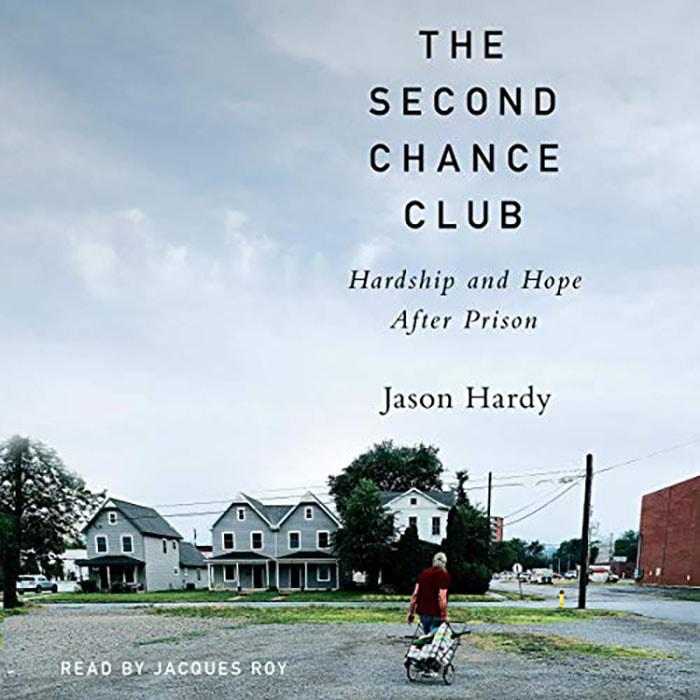|
The number of people on probation or parole in the United States is roughly double the number of people behind bars. Yet a quick search on Amazon reveals that the number of books about incarceration exceeds the number of books about probation by more than tenfold. That imbalance matters. If we don’t provide adequate services for probationers and parolees, we will fail to build on the recent trend of modest decarceration. Jason Hardy helps rectify this imbalance with The Second Chance Club, a thoughtful account of his work at the New Orleans Department of Probation and Parole (“P&P” in the local argot). In his agreeably unpretentious style, Hardy introduces himself as a failed former public school teacher, failed former novelist, and currently failing JCPenney watch salesman, who aspires to a more meaningful and remunerative career. Disgusted by mass incarceration, he responds to an advertisement for a position at P&P, which he gets simply because the desperate agency assumes that he can leave his current job without giving two weeks’ notice. During training he learns that virtually everyone else, like himself, has already washed out from other occupations. Their instructors make it clear that the department is so short of officers they will bend over backward to make sure everyone passes the training course. Hardy’s training requires him to memorize “obscure Louisiana statutes like Theft of an alligator” and provides hours of instruction on how to put on handcuffs and fire a gun. As his book later makes clear, his training did not provide him with the essentials of effective community supervision, such as skills in counseling and in navigating the social welfare bureaucracy, nor did it offer thorough knowledge of addiction and behavior change principles. Despite their insufficient training, Hardy is surprised to discover that his fellow officers are generally dedicated and even, at times, idealistic. With admirable candor, he immediately surrenders any delusions of being a savior, recognizing that P&P’s challenges are not produced by the characteristics of its officers so much as the rules under which they work. These structural challenges become clear on Hardy’s first day at work, when he is handed 220 thick files on the people he is supposed to supervise. Absorbing so much information is daunting, supervising so many people even more so. His fellow officers tell him to triage, focusing his effort on the cases that pose the highest risk and have the greatest needs. This strategy relies on the assumption that the criminal justice system is consistently accurate in measuring risk. Hardy doesn’t question this assumption, but many social scientists would. More barriers to success soon become evident. Hardy arrives at a time of transition in the department, when Louisiana—rhetorically, at least—is moving away from incarceration. What this means practically is letting slide many probation and parole infractions that once triggered harsh punishment. But it doesn’t mean that there is much more investment in services. Hardy puts his finger on the larger political challenge: “Nobody who mattered gave a shit about probation and parole.” The result is a system that in at least one sense has no bias: “P&P treated everyone equally—that is to say, poorly—because we didn’t have the resources to treat anybody well.” Hardy also makes an astute point about political economy. Much of the public simultaneously resents the high cost of prisons yet also opposes spending on services for people under community supervision, considering them “goodies for baddies.” This is spectacularly shortsighted, because providing such services is critical for diverting some people from prison to probation and keeping paroled ex-prisoners from being reincarcerated. Hardy also grapples with the system’s inability to impose consequences other than imprisonment for infractions. Fines are sometimes levied, but no one pays them, and no one is punished for not paying them. This leaves incarceration as the only way to deter violation of supervision conditions. And officers, he notes, are punished for responding to violations—it creates piles of paperwork, the need for court appearances, and then more paperwork. It’s easy for the supervisors and the supervised to fall into an implicit bargain: If you pretend you are a good supervisee, I will pretend that I’m a good officer. Hardy and his fellow officers soldier on despite it all. The heart of the book is narratives about seven of the individuals he supervises. Their problems are manifold, the most consistent being poverty and addiction. Some of them are also exploitative of others and prone to violence, and many run with a rough crowd. As a white parole officer in a notoriously corrupt city where many black people are understandably suspicious of cops, Hardy realizes that he has to overcome his charges’ skepticism. He largely succeeds, through evident compassion toward the frequently difficult and sometimes dangerous people he is assigned to supervise. Hardy struggles alongside his supervisees through the maddening process of finding psychiatric, vocational, educational, and addiction-related services. On multiple occasions, he finds that he can’t place someone in a treatment program until a physician diagnoses them with a mental health or addictive disorder, but the only way to do that is to admit the person to a treatment program in the first place. He rages and grieves, and the reader does so along with him; yet he also persists, facilitating a few victories that are an antidote to despair. Failed novelist or not, Hardy has some literary gifts that enliven the book. His regional manager wears “a constant, nervous smile, as if he’d gotten good news but was holding off on believing until he saw the proof.” Hardy also takes breaks from the pain of his subjects’ lives by adding some amusing details, such as the deep affection some offenders have for cop shows. His supervisees root for TV cops, who tend to be more professional and honorable than the real-world cops they know. And they hate TV criminals, who are portrayed as sociopathic and thus, in their view, completely different than themselves, who are just trying to get by in an unfair world. Hardy deserves credit for providing counterexamples to common liberal pieties about his work, including ones he previously espoused himself. He finds that, rather than being the exclusive purview of racist whites, tough-on-crime attitudes are prevalent among poor, black residents of neighborhoods with high crime rates. He also highlights examples where actual or threatened punishment has a positive impact. One woman struggling with addiction thanks him for sending her to jail after a relapse, because it helped her turn her life around. Another woman plans to get high but chooses not to because she realizes that she has a drug test coming up. He is also candid about the fact that the social welfare programs he advocates, such as food stamps and Social Security, are often abused by scammers. Indeed, he observes sadly that bureaucratic rules around these programs are often easier for determined con artists to overcome than they are for the sick and the needy. A healthy, intelligent drug dealer can supplement his income by faking chronic pain, making all his doctor’s appointments, and filling out all of the required disability forms. Someone who is actually living in excruciating pain finds these same steps much more challenging. These insights help compensate for the things that Hardy gets wrong. He relentlessly touts what the law professor John Pfaff calls the “standard story” of mass incarceration: that our large prison populations are a consequence of drug prohibition, which was designed to fill prisons with black people. This is not a criticism of Hardy in particular, as the standard story has been repeated in countless media stories, movies, and academic journal articles. In fact, drug offenders are only about one-sixth of U.S. prisoners, and if they were all released tomorrow the proportion of prisoners who are African American would go up rather than down. Further, the drug that drives by far the most crime, arrests, and incarceration is legal: alcohol. On that latter point, it is discouraging that everyone in Hardy’s department, including him, ignores heavy drinking by their supervisees, yet virtually all of them lecture their charges to avoid “drugs.” Hardy’s analysis of the appeal of drug dealing to his supervisees and to low-income people more generally is partly false and partly true. He repeatedly describes drug dealing as lucrative, when careful research by Robert MacCoun and Peter Reuter shows that it’s a boom-or-bust business; over a typical year, it pays less than a steady minimum-wage job. He’s on stronger ground when he points to the appeal of the lifestyle to some young men, particularly being feared and being attractive to young women. But the strengths of the book shine through. The Second Chance Club illuminates the lives of people who provide and receive community supervision, and it lays out necessary structural changes. Hardy makes a powerful case that minimal funding for community supervision increases risks to those in the system and the people around them. This is bad enough in itself, but it is also penny-wise and pound-foolish. Many offenders end up back in prison, costing taxpayers even more than it would have to adequately fund parole and probation. That’s to say nothing of the human cost. Hardy’s other critical point is that a system that relies exclusively on ignoring violations or handing out long prison terms will fail to change behavior, protect public safety, and provide justice. Finding an intermediate route for responding to violations is one of the central goals of the “swift, certain, and fair” approaches to community supervision that were described in this magazine in 2013 by the late Mark Kleiman. Such systems combine frequent testing for drug use with transparent, pre-specified, and modest consequences (for example, a single night in jail instead of a return to prison to serve out one’s term). This approach also minimizes staff paperwork and delays when supervisors report an infraction to the judge. Evidence shows that swift, certain, and fair systems reduce substance use, crime, and reincarceration among people on community supervision. Reformers should look to these strategies as one solution to many of the problems that Hardy documents in his candid, engaging book.
0 Comments
Leave a Reply. |
HISTORY
April 2024
Categories |
© Walk 4 Change. All rights reserved.


 RSS Feed
RSS Feed